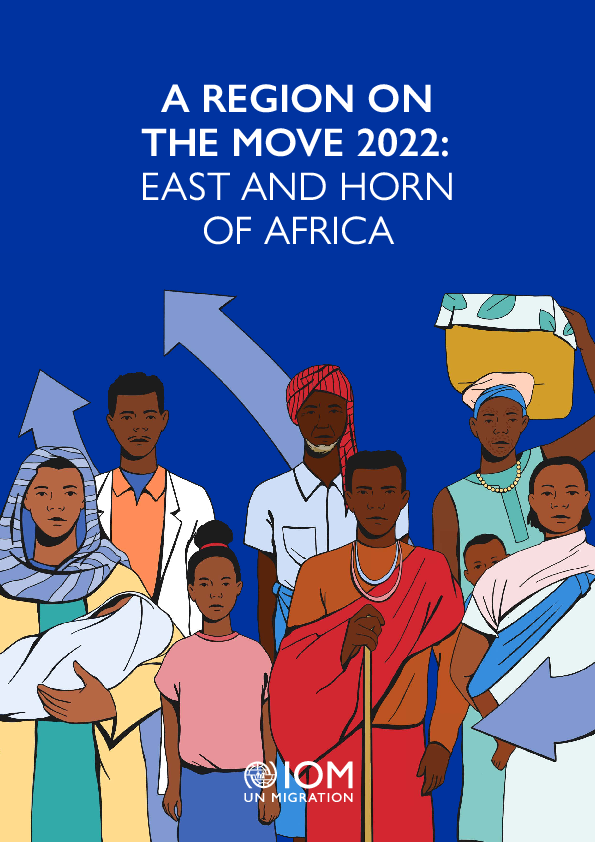-
Countries
-
Data and Analysis
-
Special Focus
-
Crisis Responses
Compilation/Overview
Color
white
In the Middle East and North Africa (MENA) region, there were 16.2 million internally displaced persons (IDPs) as of end 2022. This figure constitutes 23 per cent of the global number of IDPs, making MENA the region with the second highest concentration of IDPs following the sub-Saharan Africa region. Most displacement in the MENA region (80%) has been triggered by armed conflict, particularly in Iraq, Libya, Syria and Yemen.
This report covers DTM activities in five countries (Iraq, Libya, Sudan, Yemen, and Lebanon) from April 2023 to June 2023. All five countries implemented mobility tracking activities. Flow monitoring in operational in Yemen and Libya, through a network of flow monitoring points (FMP) and Flow Monitoring Surveys with the main aim of tracking cross-border movement trends in the region.
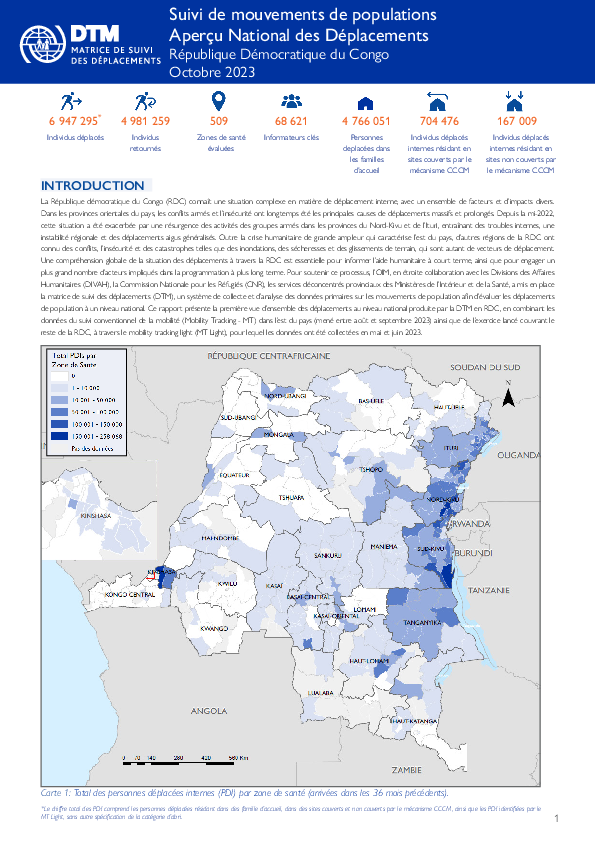
Contact
DTM DRC, iomdrcdtm@iom.int
Language
English
Location
Democratic Republic of the Congo
Period Covered
May 01 2023
Sep 12 2023
Activity
- Mobility Tracking
- Baseline Assessment
La République démocratique du Congo (RDC) connaît une situation complexe en matière de déplacement interne, avec un ensemble de facteurs et d’impacts divers. Dans les provinces orientales du pays, les conflits armés et l’insécurité ont longtemps été les principales causes de déplacements massifs et prolongés. Depuis la mi-2022, cette situation a été exacerbée par une résurgence des activités des groupes armés dans les provinces du Nord-Kivu et de l’Ituri, entraînant des troubles internes, une instabilité régionale et des déplacements aigus généralisés. Outre la crise humanitaire de grande ampleur qui caractérise l’est du pays, d’autres régions de la RDC ont connu des conflits, l’insécurité et des catastrophes telles que des inondations, des sécheresses et des glissements de terrain, qui sont autant de vecteurs de déplacement. Une compréhension globale de la situation des déplacements à travers la RDC est essentielle pour informer l’aide humanitaire à court terme, ainsi que pour engager un plus grand nombre d’acteurs impliqués dans la programmation à plus long terme. Pour soutenir ce processus, l’OIM, en étroite collaboration avec les Divisions des Affaires Humanitaires (DIVAH), la Commission Nationale pour les Réfugiés (CNR), les services déconcentrés provinciaux des Ministères de l’Intérieur et de la Santé, a mis en place la matrice de suivi des déplacements (DTM), un système de collecte et d’analyse des données primaires sur les mouvements de population afin d’évaluer les déplacements de population à un niveau national. Ce rapport présente la première vue d’ensemble des déplacements au niveau national produite par la DTM en RDC, en combinant les données du suivi conventionnel de la mobilité (Mobility Tracking - MT) dans l’est du pays (mené entre août et septembre 2023) ainsi que de l’exercice lancé couvrant le reste de la RDC, à travers le mobility tracking light (MT Light), pour lequel les données ont été collectées en mai et juin 2023.
Au niveau national, la DTM a identifié 6 947 295 personnes déplacées internes (PDI), principalement concentrées dans les quatre provinces orientales du Nord-Kivu (2 300 163 personnes), de l’Ituri (1 630 535), du Sud-Kivu (1 356 376) et du Tanganyika (350 462), ainsi que dans la province/ville de Kinshasa à l’ouest du pays (392 281). Ces cinq provinces représentent à elles seules la grande majorité (87%) des déplacements actuels en RDC. Les 21 provinces restantes représentent 13 pour cent du nombre total de personnes déplacées dans le pays (917 478 personnes).
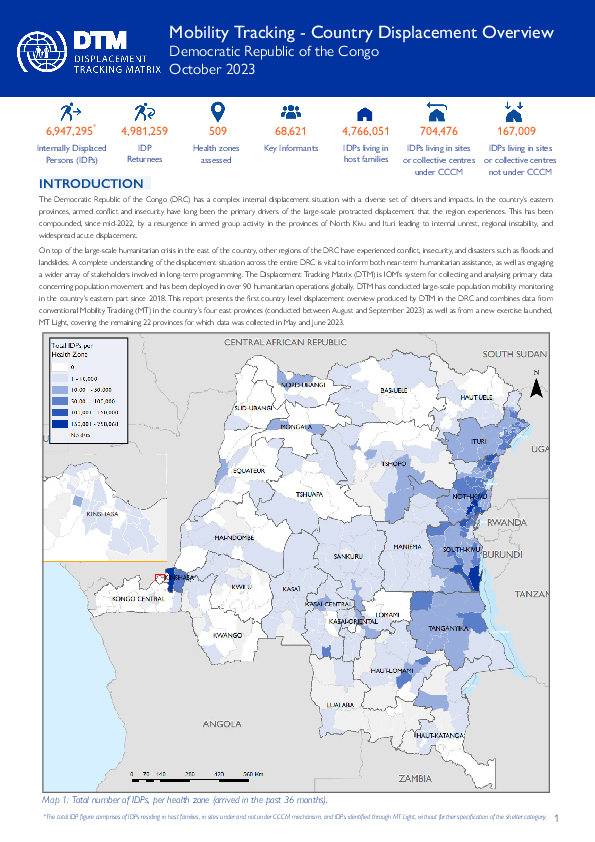
Contact
DTM DRC, iomdrcdtm@iom.int
Language
English
Location
Democratic Republic of the Congo
Period Covered
May 01 2023
Sep 12 2023
Activity
- Mobility Tracking
- Baseline Assessment
The Democratic Republic of the Congo (DRC) has a complex internal displacement situation with a diverse set of drivers and impacts. In the country’s eastern provinces, armed conflict and insecurity have long been the primary drivers of the large-scale protracted displacement that the region experiences. This has been compounded, since mid-2022, by a resurgence in armed group activity in the provinces of North Kivu and Ituri leading to internal unrest, regional instability, and widespread acute displacement. On top of the large-scale humanitarian crisis in the east of the country, other regions of the DRC have experienced conflict, insecurity, and disasters such as floods and landslides. A complete understanding of the displacement situation across the entire DRC is vital to inform both near-term humanitarian assistance, as well as engaging a wider array of stakeholders involved in long-term programming. The Displacement Tracking Matrix (DTM) is IOM’s system for collecting and analysing primary data concerning population movement and has been deployed in over 90 humanitarian operations globally. DTM has conducted large-scale population mobility monitoring in the country’s eastern part since 2018. This report presents the first country level displacement overview produced by DTM in the DRC and combines data from conventional Mobility Tracking (MT) in the country’s four east provinces (conducted between August and September 2023) as well as from a new exercise launched, MT Light, covering the remaining 22 provinces for which data was collected in May and June 2023.
At a national level, DTM identified 6,947,295 individual internally displaced persons (IDPs), primarily concentrated in the four eastern provinces of North Kivu (2,300,163 individuals), Ituri (1,630,535), South Kivu (1,356,376), and Tanganyika (350,462) as well as the province/city of Kinshasa in the west of the country (392,281). These five provinces alone account for the considerable majority (87%) of current displacement in the DRC. The remaining 21 provinces account for 13 per cent of the total number of IDPs in the country (917,478 individuals).
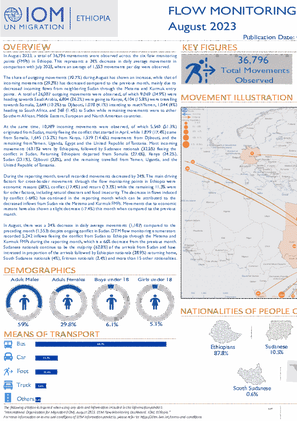
Contact
DTM Ethiopia, DTMEthiopia@iom.int
Language
English
Location
Ethiopia
Period Covered
Aug 01 2023
Aug 31 2023
Activity
- Flow Monitoring
In August 2023, a total of 36,796 movements were observed across the six flow monitoring points (FMPs) in Ethiopia. This represents a 24% decrease in daily average movements in comparison with July 2023, where an average of 1,553 movements per day were observed.
The share of outgoing movements (70.7%) during August has shown an increase, while that of incoming movements (29.3%) has decreased compared to the previous month, mainly due to decreased incoming flows from neighboring Sudan through the Metema and Kurmuk entry points. A total of 26,007 outgoing movements were observed, of which 9,069 (34.9%) were heading towards Saudi Arabia, 6,804 (26.2%) were going to Kenya, 4,104 (15.8%) were travelling towards Somalia, 2,649 (10.2%) to Djibouti, 1,078 (4.1%) intending to reach Yemen, 1,044 (4%) heading to South Africa, and 368 (1.4%) to Sudan while remaining movements were to other Southern African, Middle Eastern, European and North American countries.
At the same time, 10,789 incoming movements were observed, of which 5,540 (51.3%) originated from Sudan, mainly fleeing the conflict that started in April, while 1,879 (17.4%) came from Somalia, 1,645 (15.2%) from Kenya, 1,579 (14.6%) movements from Djibouti, and the remaining from Yemen, Uganda, Egypt and the United Republic of Tanzania. Most incoming movements (63.1%) were by Ethiopians, followed by Sudanese nationals (32.5%) fleeing the conflict in Sudan. Returning Ethiopians departed from Somalia (27.6%), Kenya (24.2%), Sudan (23.1%), Djibouti (23%), and the remaining travelled from Yemen, Uganda, and the United Republic of Tanzania.
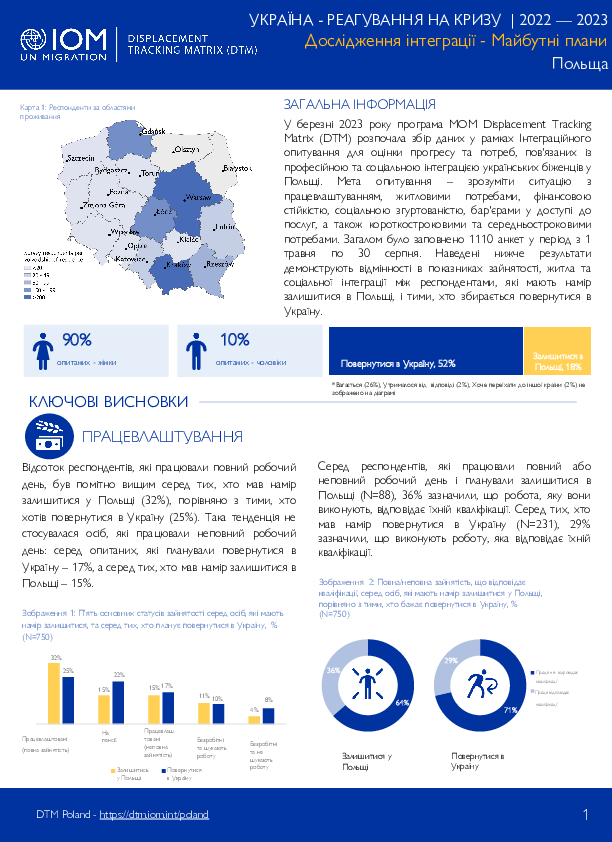
Contact
DTM Europe, DTMMediterranean@iom.int
Language
Ukrainian
Location
Poland
Period Covered
May 01 2023
Aug 30 2023
Activity
- Survey
- Return Intention
У березні 2023 року програма МОМ Displacement Tracking Matrix (DTM) розпочала збір даних у рамках Інтеграційного опитування для оцінки прогресу та потреб, пов'язаних із професійною та соціальною інтеграцією українських біженців у Польщі. Мета опитування – зрозуміти ситуацію з працевлаштуванням, житловими потребами, фінансовою стійкістю, соціальною згуртованістю, бар'єрами у доступі до послуг, а також короткостроковими та середньостроковими потребами. Загалом було заповнено 1110 анкет у період з 1 травня по 30 серпня. Наведені нижче результати демонструють відмінності в показниках зайнятості, житла та соціальної інтеграції між респондентами, які мають намір залишитися в Польщі, і тими, хто збирається повернутися в Україну.
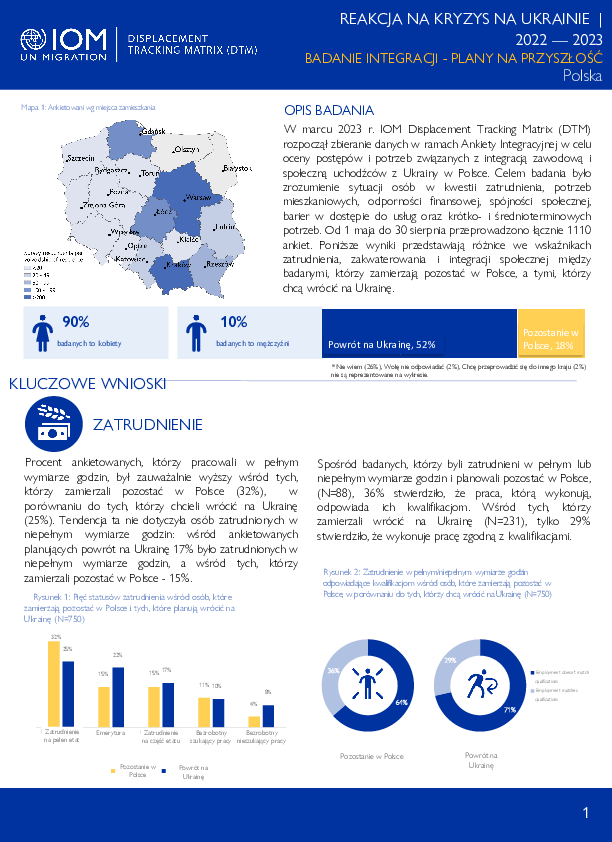
Contact
DTM Europe, DTMMediterranean@iom.int
Language
English
Location
Poland
Period Covered
May 01 2023
Aug 30 2023
Activity
- Survey
- Return Intention
W marcu 2023 r. IOM Displacement Tracking Matrix (DTM) rozpoczął zbieranie danych w ramach Ankiety Integracyjnej w celu oceny postępów i potrzeb związanych z integracją zawodową I społeczną uchodźców z Ukrainy w Polsce. Celem badania było zrozumienie sytuacji osób w kwestii zatrudnienia, potrzeb mieszkaniowych, odporności finansowej, spójności społecznej, barier w dostępie do usług oraz krótko- i średnioterminowych potrzeb. Od 1 maja do 30 sierpnia przeprowadzono łącznie 1110 ankiet. Poniższe wyniki przedstawiają różnice we wskaźnikach zatrudnienia, zakwaterowania i integracji społecznej między badanymi, którzy zamierzają pozostać w Polsce, a tymi, którzy chcą wrócić na Ukrainę.

Contact
DTM Europe, DTMMediterranean@iom.int
Language
English
Location
Poland
Period Covered
May 01 2023
Aug 30 2023
Activity
- Survey
- Return Intention
In March of 2023, IOM’s Displacement Tracking Matrix (DTM) launched its Integration Survey data collection exercise to assess the progress and needs relating to labour and social integration of refugees from Ukraine in Poland. The aim of the assessment is to gain an understanding of the employment situations, housing needs, financial resilience, social cohesion, barriers to accessing services, and short-medium term needs of refugees. In the reporting period of 1 May - 30 August, a total of 1,110 surveys were conducted. The findings below reflect the differences in employment, accommodation, and social inclusion indicators between respondents who intend to remain in Poland as compared to those who intend to return to Ukraine.

Contact
DTM Nigeria, iomnigeriadtm@iom.int
Language
English
Location
Nigeria
Period Covered
Dec 12 2022
Jan 14 2023
Activity
- Survey
As of February 2023, 2,200,679 individuals were internally displaced in the BAY (Borno, Adamawa and Yobe) states of the north-east region, and 2.17 million individuals returned to their locations of origin. The unpredictability of the security crisis in BAY states has left for fluid mobility in these areas. This, coupled with the closure of major camps in Maiduguri Metropolitan Council (MMC), Jere and Konduga local government areas (LGAs) of Borno State. Many IDPs who resided in these camps have now integrated in host communities where they were displaced, some have reintegrated in their LGAs of origin and others have moved to different LGAs for resettlement.
To help find durable solutions for internal displacement — whether through return to communities of origin, local integration, or relocation – and to prevent new displacements in the region, it is critical to understand the relative levels of stability in locations hosting returnees or displaced populations. IOM launched the Stability Index (SI) in 2019 to evaluate the stability of areas hosting returnees or displaced populations in Nigeria. The SI seeks to understand factors influencing a location's stability to identify priority interventions for transition and recovery, with the goal of strengthening the resilience and stability in this conflict and displacement-affected region. The Stability Index measures perceptions of stability and analyzes factors having a larger impact on the decisions of populations to remain in place or move. The tool is implemented in the BAY states to enable governmental authorities and partners to develop better strategies, and to prioritize resources that link humanitarian, recovery, and stabilization approaches.
This report presents results from data collection of Stability Index Round 3 conducted in Nigeria’s BAY states (Borno, Adamawa and Yobe) between December 2022 and January 2023.

Contact
DTMAfghanistan@iom.int
Language
English
Location
Afghanistan
Period Covered
Aug 01 2023
Aug 31 2023
Activity
- Flow Monitoring
The snapshot captures present mobility and displacement trends between Afghanistan, the Islamic Republic of Iran and Pakistan.
The 'A Region on the Move' report series for the East and Horn of Africa' has been the regional flagship publication since 2017. The series provides an advanced understanding of the main migrant groups and the environment in which mobility takes place, with a focus on internal displacement and mixed migration flows along the major migration corridors of this region. A Region on the Move 2022, the tenth report in the series, explores mobility dynamics affecting the East and Horn of Africa region across its broader spectrum: from providing a regional overview of data and trends on international migrants to discussing specific groups of migrants, namely migrant workers, refugees, asylum seekers, internally displaced persons and irregular migrants along the main migratory corridors.
Pagination
- Previous page
- Page 17
- Next page

